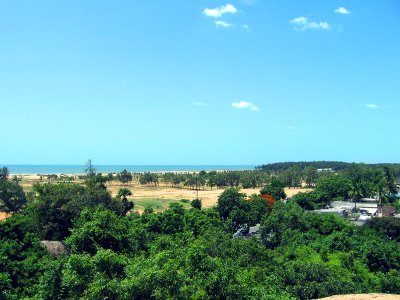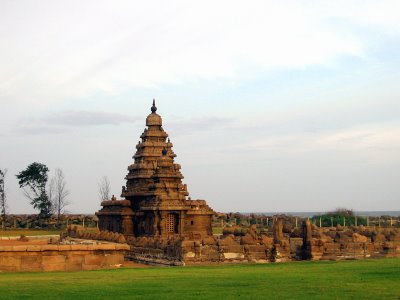Mamallapuram I

From ancient times there was a port at Mamallapuram, and Romans and Han alike came to trade there. It was the Pallava kings who started to build the port into something more, turning it from a mere place to trade into a city that would show their magnificence and power. For generations they built, and the sea port became a city, second only to the royal capital of Kanchiapuram.
It was at this time that the Chalukya's were rising to the north, a fierce dynasty descended from the ancient trader kings of Satavahana. So fierce was their reputation that it was said they could not be defeated, and that the thunder of the charge of their elephants was enough to throw down city walls by its sound alone. Hsuan Tsang, Buddhist monk and world traveler, listed the great Chalukya king Pulakesi II as one of the greatest lords of the earth – and as Hsuan Tsang had traveled from China to Persia and throughout all of Asia, he had reason to know what made a great lord.
Mighty Pulakesi turned his eyes southwards towards the Pallava's, and the wealth they gathered through their mastery of the South and the rich ports there. Bringing his elephants he met the visionary poet-king of the Pallavas, Mahendravarman, and defeated him in battle. The Pallavas were forced to hide behind the walls of Kanchipuram while the Chalukya's sacked and seized the wealth of the country.
Palakesi moved on in time, for there were other kingdoms to conquer, and his greed could not be sated. Mahendravarman passed on, and his son took the throne. Narasimhavarman I was a visionary like his father, who gave great endowments to artists and poets and priests, but he was also a great warrior. His prowess in unarmed combat was such that he was known as Mamallan – the great wrestler. He gathered up the scattered armies of the Pallavas and marched north to fight against Pulakesi. In a battle that shook the world and changed the history of India forever, the great wrestler defeated the unstoppable king, sacked his capital city, and ended his life.
Bringing back gold and glory, Mamallan turned his attention to the port city his father had started to invest and turned it into a marvel the whole world would envy. The greatest artisans of the day were brought in, temples and monuments were constructed, and the port was expanded. At its height the great port of Mamallan, know in his honor as Mamallapuram, sent ships to invade Sri Lanka, to trade with Malaysia and Thailand, and to colonize Cambodia in a wave that would help birth the great Khmer kings.
This trade brought great wealth into Mamallapuram, and its artisans learned to do things with stone that defied imagination. They built and built their city, carving dreams into stone and making them soar until the gods themselves looked on in amazement. And when the gods become amazed, mortals should know fear. For that amazement turns to jealousy, and jealous gods do not let the works of man remain to mock them.

The sea itself rose up against Mamallapuram. The most beautiful city of the earth was swallowed by the waves, until only a fraction of it remained. Once, it is said, there were seven great temples that marched from the center of town down to the shore and the ports. Of these brothers six were swallowed by the waters, leaving only one temple alone to watch the waves that had taken its city and its worshipers.
Nor was the sea done. Time and time again it would come against the Shore Temple and try to wrestle it into submission, to drag it beneath the waves with the rest of the lost city. Three times the sea nearly succeeded: in cyclone, in hurricane, and in tsunami the temple was battered and bruised. Once its cap stone was even dragged out into the water, and only the reverence of the locals allowed it to be saved – dragged out of the deeps and returned to its plinth.
Ages passed, and the grandeur of Mamallapuram was forgotten, fading only to dim memories and myths. Its great chariot temples were buried beneath the sand and lost to the eyes of men for a thousand years. Its harbor closed and became nothing more than local fishers who would not sail past the seventh wave. No longer was it a place that men in far lands spoke of with wonder. But even then the shore temple stood, and those who sailed past that point would look at it and wonder. Who built this great temple, this lookout who defies the gods and the sea itself, wrestling with both time and tide?
In time it was that great wrestler who brought men of science to the city. They uncovered the rathas beneath the sand, they recovered the lost names of kings who had ruled the Indian ocean from this port, and in time they even found the ruins of the greatest city under the waters of the Bay of Bengal. And through it all the Shore Temple stood, watching the watery grave of its brothers and marking a still point in which the past refused to die.

It is the great wrestler of Mamallapuram. For 1338 years it has stood against the gods, the ocean, and time itself. While the whole city it watched over was swept away, while dynasties were ground into dust, while foreigners invaded and were driven out again, and while India forgot and finally rediscovered itself it has fought against all. Though scarred and battered, it stands and watches the waves so that its brothers, its past, and its kings will not be forgotten.



0 Comments:
Post a Comment
<< Home